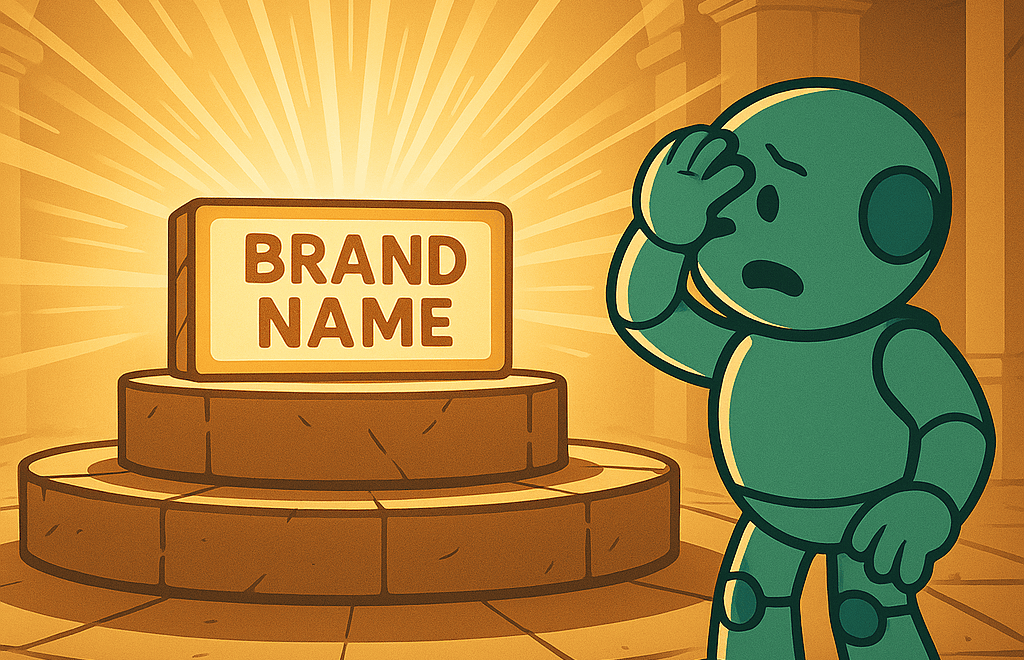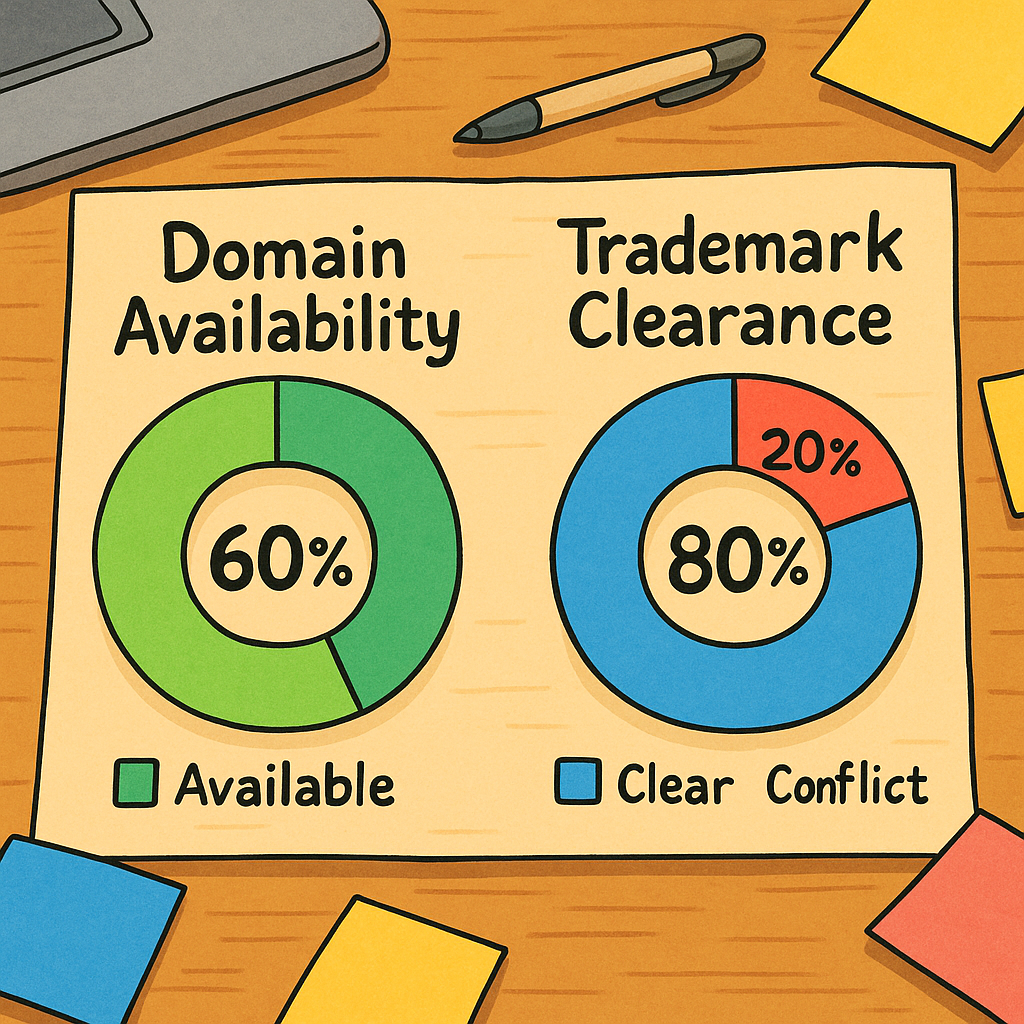How to Name a Brand: Expert Tips for Memorable Names
Why Your Brand Name Can Make or Break Your Business

A brand name is more than a simple label. It's the foundation of your business identity, the first impression for customers, and the cornerstone of how they perceive your products or services. A strong brand name creates instant recognition and builds an emotional connection with your target audience. This makes choosing the right name a critical step in building a successful brand. It's a crucial investment in your future, paving the way for lasting recognition and strong customer loyalty.
The Impact of a Strong Brand Name
A well-chosen brand name is a valuable asset, contributing significantly to several key aspects of your business:
-
Brand Recognition: A memorable name helps customers quickly identify and remember your brand, especially in competitive markets. Consider iconic brands like Google or Nike. These names are instantly recognizable and synonymous with their industries.
-
Customer Loyalty: A name resonating with your target audience fosters connection and trust, increasing customer loyalty and encouraging repeat business. A brand name suggesting reliability and quality, for example, will naturally attract customers seeking those attributes.
-
Market Differentiation: A unique name distinguishes your brand from competitors, improving visibility and memorability. This is essential in saturated markets where standing out is crucial for success.
-
Brand Equity: Over time, a successful brand name builds equity, becoming a valuable asset contributing to your business's overall worth. This translates to higher perceived value and potentially greater pricing power.
The Risks of a Weak Brand Name
Conversely, a poorly chosen name can hinder growth and even lead to business failure. Here are some common pitfalls:
-
Generic Names: Descriptive or common names are easily forgotten and fail to differentiate your brand. "Acme Solutions," for example, doesn't create a distinct brand image.
-
Negative Connotations: Names with negative connotations or unintended meanings can damage your brand’s reputation, particularly in international markets with varying cultural sensitivities.
-
Trademark Issues: Choosing a name infringing on existing trademarks can lead to expensive legal disputes and force a costly rebrand. A unique brand name is crucial for establishing a clear identity and market presence.
In 2023, there were 88.2 million active registered trademarks globally, with U.S. companies holding approximately 3.5 million (3.97%). This high volume underscores the importance of unique and memorable brand names. Furthermore, global trademark offices received 15.2 million applications in 2023, with research and technology companies leading filings within the U.S. This highlights the competitive landscape and the need for distinctive names. More detailed statistics can be found here: https://capitaloneshopping.com/research/branding-statistics/
The Importance of Strategic Naming
Effectively naming a brand is a strategic process involving careful consideration of your target audience, market positioning, and long-term business objectives. It's a vital investment requiring thorough research, testing, and legal due diligence. Ultimately, the right brand name can become a cornerstone of your success, while a poorly chosen name can become a major obstacle.
Research That Reveals What Actually Works in Naming

Before brainstorming creative names, effective branding starts with research. This ensures your chosen name resonates with your target audience, reflects your brand identity, and sets you up for success. It's like laying the foundation for a house—essential for stability. This involves understanding your audience, analyzing your competition, and identifying prevailing trends.
Audience Preference Mapping
Understanding your target audience is critical. Who are they? What are their values and needs? Effective research goes beyond demographics to understand their lifestyles, motivations, and what they aspire to. For example, a brand targeting environmentally conscious consumers might choose a name that evokes nature or sustainability. This ensures a strong emotional connection.
Competitor Name Auditing
Analyzing competitor names helps you understand what works—and what doesn't—in your industry. What naming conventions are common? What opportunities exist for differentiation? This provides valuable market insights. For instance, if competitors favor descriptive names, an abstract name might make your brand stand out. This strategic analysis prevents your brand from fading into the background. For more on naming tools and strategies, check out this resource on business name generators.
Analyzing Naming Trends
Staying current with naming trends is key to a relevant brand name. However, avoid generic terms that quickly become dated. Focus on broader cultural shifts and consumer preferences that influence naming conventions. This balance ensures your name feels fresh yet timeless. Global market trends are another factor to consider. A YouGov survey revealed that many consumers prefer established brands. In the United Arab Emirates, 51% of respondents stated they primarily buy well-known brands, compared to 34% in the U.S. Brand recognition is clearly vital for market share. The impact of celebrity endorsements also varies by market, influencing 48% of Indonesian respondents. Detailed statistics are available here.
Thorough research creates a strong foundation for impactful brand names. This ensures your name resonates with your audience, differentiates you from competitors, and aligns with current trends. By understanding effective naming practices, you set your brand up for long-term success.
Creative Methods That Generate Unforgettable Names

The infographic above illustrates the crucial interplay between domain availability and trademark clearance in the brand naming process. While 60% of brainstormed names may have available domains, only 80% of those are likely to be trademark-clear. This highlights the importance of combining creative brainstorming with thorough legal due diligence to ensure your chosen name is both memorable and legally sound.
Creating a truly unforgettable brand name goes beyond simply combining words. Professional brand architects employ structured brainstorming and proven naming techniques, ranging from linguistic approaches to metaphorical thinking, to forge a strong and resonant brand identity.
Linguistic Techniques: Crafting Names With Sound and Meaning
Syllabic construction focuses on building names from the sounds of syllables. This approach creates distinctive and memorable names. Short, punchy names like "Kodak" or "TikTok" are easy to recall and project a modern feel.
Morpheme combination, on the other hand, blends meaningful word parts. Think "Instagram" (instant + telegram). This technique layers meaning into the name and effectively communicates the brand's purpose.
Metaphorical Naming: Evoking Imagery and Emotion
Metaphorical naming connects your brand to other concepts, creating strong imagery and emotional resonance. "Red Bull," for example, leverages the image of a powerful animal to suggest energy and vitality. This approach imbues your brand name with a story and helps it leave a lasting impression.
To further illustrate the different techniques available, let's examine a comparison table outlining the strengths and weaknesses of each approach.
Brand Naming Techniques Comparison: A comparison of different brand naming approaches with examples and effectiveness ratings.
| Naming Technique | Description | Famous Examples | Pros | Cons | Best For |
|---|---|---|---|---|---|
| Syllabic Construction | Creating names based on sound and syllables | Kodak, TikTok | Memorable, modern, easy to pronounce | Can be meaningless, difficult to find available domains | Tech companies, modern brands |
| Morpheme Combination | Blending meaningful word parts | Instagram, Microsoft | Meaningful, communicates brand purpose | Can be lengthy, difficult to pronounce | Brands with a clear purpose, established industries |
| Metaphorical Naming | Using metaphors to evoke imagery and emotion | Red Bull, Amazon | Creates strong imagery, memorable, tells a story | Can be abstract, difficult to translate | Brands with a strong visual identity, lifestyle brands |
| Descriptive Naming | Clearly describing what the brand offers | General Electric, Toys "R" Us | Easy to understand, communicates brand function | Can be generic, uninspiring | Practical brands, B2B companies |
| Eponymous Naming | Using the founder's name | Ford, Disney | Builds brand legacy, strong association with founder | Can be limiting if the founder's reputation changes | Family businesses, personal brands |
This table highlights how different naming techniques can be applied to various brand archetypes, emphasizing the importance of aligning the chosen method with the overall brand strategy.
Brainstorming Best Practices: Fueling Creativity and Overcoming Blocks
Effective brainstorming is essential for generating high-quality name options. Structured brainstorming techniques, such as word association or mind mapping, help teams stay focused and produce a larger pool of ideas. A skilled facilitator can help overcome creativity blocks and encourage teams to think outside the box. This collaborative approach can uncover fresh perspectives and lead to innovative name combinations.
Evaluating Names Objectively: Beyond Personal Preferences
Evaluating potential names based on objective criteria is crucial. Consider factors like pronunciation, cultural resonance, and emotional associations across different audience segments. This nuanced approach helps ensure the chosen name resonates with your target audience and avoids unintended interpretations.
Digital Tools for Naming: Identifying Viable Options
Several digital tools can assist in brand naming. Some offer advanced features like linguistic analysis, offering insights into the impact of different sounds and structures. However, many generate generic and unmemorable options. Discerning between valuable tools and those offering little value is key to streamlining the naming process. This includes checking domain availability, search visibility, and conducting thorough trademark clearance searches.
Testing Your Name Options: Beyond Gut Reactions

After brainstorming potential brand names, the next step is testing. This goes beyond initial reactions. It requires structured validation to see which names resonate with your target audience and align with your brand identity. Testing differentiates exceptional names from adequate ones, providing data-driven insights for confident decisions.
Designing Tests for Memorability and Appeal
Initial appeal doesn't guarantee long-term memorability. Designing tests that measure genuine memorability is critical. These tests involve presenting names to your target audience and assessing their recall after a set time.
For instance, show participants a list of names. Then, ask them to recall those names after 30 minutes. This reveals which names truly stick.
Assessing Pronunciation, Cultural Resonance, and Emotional Associations
A good brand name goes beyond memorability. It evokes emotions and aligns with cultural values. Testing pronunciation across diverse demographics ensures the name is easily understood and remembered.
Assessing cultural resonance identifies potential misinterpretations or negative connotations in different markets. A name that sounds appealing in English might have an unfavorable meaning in another language. This step avoids unintended cultural misunderstandings.
Digital Viability Testing: Beyond Domain Checks
Securing a matching domain is essential, but digital viability is more than just domain availability. Assessing search visibility potential determines how easily your brand name is found online. This includes researching keyword rankings and analyzing search engine results pages (SERPs).
With the rise of voice search, testing voice assistant recognition is increasingly important. This ensures your brand name is easily recognized by virtual assistants like Siri or Alexa. This is particularly relevant for brands targeting younger demographics.
A/B Testing for Actionable Data
A/B testing offers a structured way to compare different name options. Presenting two or more names to distinct audience groups gathers data on which name performs best. Metrics include memorability, preference, and perceived relevance.
This data-driven approach provides objective insights, mitigating the risk of relying on personal preferences. Properly executed A/B testing provides clear data for informed decisions. This ensures the chosen name resonates with your target market and represents your brand identity. Thoroughly testing your brand names increases your chances of selecting a name that supports long-term success. This reinforces the idea that naming a brand is a strategic process. Using tools like NameRobot can improve this process. For example, the NameScore tool analyzes a name's usability.
Protecting Your Perfect Name: Legal Essentials
Finding the perfect brand name is a significant achievement, but it's only the first step. A captivating name becomes worthless if you can't legally use it. This section explores the crucial legal aspects of brand naming, ensuring your chosen name is both memorable and legally sound.
Trademark Protection: Securing Your Brand's Identity
Trademark protection is essential for safeguarding your brand name and preventing unauthorized use. It’s the legal safeguard protecting your brand’s identity. This protection grants exclusive rights to use your brand name concerning the specific goods or services you offer.
-
Comprehensive Trademark Searching: Begin with a thorough search across relevant jurisdictions and industries. This helps identify potential conflicts with existing trademarks, preventing legal challenges later.
-
Understanding Descriptiveness Challenges: Avoid descriptive names that simply describe the product or service. These are difficult to trademark. For instance, "Delicious Coffee" for a coffee brand is descriptive and therefore weak.
-
Navigating Geographic Limitations: Trademark protection is often geographically limited. If you plan international expansion, consider securing trademark registrations in your target markets.
You might be interested in: How to master trademark law
Costs and Timelines: Planning Your Legal Budget
Securing trademark protection involves costs and time, varying depending on the jurisdiction and the application's complexity.
-
Trademark Application Fees: These fees differ significantly between countries. Factor these costs into your budget early in the naming process.
-
Legal Counsel: Consider hiring a trademark attorney to navigate the legal complexities. While this adds to upfront costs, professional guidance can prevent expensive legal battles later.
-
Timelines for Registration: Trademark registration can take several months or even years. Account for this timeline when planning your product launch or marketing campaigns.
Alternative Protection Strategies: Safeguarding Your Brand on a Budget
If budget constraints prevent comprehensive trademark registration, explore alternative protection strategies:
-
"Common Law" Trademark Rights: Consistently using your brand name in commerce can establish some trademark protection, even without formal registration. This provides some defense against infringers.
-
Registered Copyright: While not as robust as trademark protection for brand names, copyrighting your logo or other brand elements offers an additional layer of protection.
Responding to Office Actions and Oppositions: Navigating Legal Challenges
Even with careful planning, you might encounter legal obstacles.
-
Office Actions: Trademark offices might issue office actions requesting clarification or revisions to your application. Prompt and accurate responses are crucial for successful registration.
-
Oppositions: Competitors might oppose your trademark application. A strong legal strategy and clear evidence of your brand's usage can help overcome oppositions.
The value of a strong brand name is clear in the market dominance of leading brands. In 2025, Apple's brand value reached an estimated $574.5 billion, followed by Microsoft at $461.1 billion. These brands have effectively leveraged their names, resonating with consumers and contributing to impressive valuations. The collective value of the top 5,000 global brands increased from $11 trillion to over $13 trillion in 2024, highlighting the growing importance of strong brand identities. Explore this topic further: Brand Value Statistics
Proactive Legal Strategies: Integrating Legal Considerations Into Your Naming Process
Integrating legal considerations into your naming process from the start is the most effective approach, saving time and resources.
-
Preliminary Trademark Screening: Conduct initial trademark searches during brainstorming to identify and eliminate potentially problematic names early.
-
Legal Counsel During Brainstorming: Consulting a trademark attorney during brainstorming sessions can help identify legal red flags and guide your team toward legally sound names.
This proactive approach ensures legal issues are addressed before you become attached to a name that might face future legal challenges. By following these steps, you can protect your perfect name and build a strong, legally sound brand identity.
Real-World Naming Success Stories (And Failures to Avoid)
Learning from both triumphs and disasters in brand naming is crucial for effective navigation of the naming process. Analyzing real-world examples offers invaluable insights and helps avoid common pitfalls. This exploration delves into the strategic thinking behind successful names, the challenges encountered, and the outcomes achieved.
From Backrub to Google: The Evolution of an Iconic Name
The story of Google's naming journey is compelling. Originally called "BackRub," reflecting its initial function of analyzing backlinks, the founders recognized the name lacked memorability and broad appeal. The transition to "Google," a play on "googol," signaled a shift towards a more user-friendly brand identity. This seemingly simple change proved crucial for global recognition and market dominance. For more on Google's naming strategy, see What We Have Learned From Google's Decision to Call Itself Alphabet.
Accenture's Strategic Rebrand: From Andersen Consulting to a Distinct Identity
When Andersen Consulting separated from Arthur Andersen, it faced the challenge of creating a distinct brand identity. "Accenture," a portmanteau of "accent on the future," projected a forward-looking vision. This strategic rebranding established a unique market position and built recognition in the competitive consulting industry. It demonstrates the power of a well-chosen name to redefine a brand.
Lessons Learned From Startups to Established Brands
Analyzing naming approaches across different business stages reveals effective techniques. Startups often prioritize catchy, memorable names to generate buzz. Established brands undergoing rebrands focus on maintaining brand equity while signaling evolution. Examining these approaches helps tailor a naming strategy.
-
Startups: Short, memorable names often resonate best with younger audiences. Consider examples like "Spotify" or "Slack."
-
Established Brands: Retaining core names while reflecting updated values is crucial. Think of "Coca-Cola Zero Sugar."
To illustrate the impact of naming on brand value, let's examine some industry trends. The following table highlights how different naming approaches contribute to brand growth.
Brand Value Statistics by Industry
A comparison of brand value growth across different industries and naming approaches
| Industry | Average Brand Value Growth | Naming Trend | Notable Examples |
|---|---|---|---|
| Technology | 15% | Short, evocative names | Google, Apple |
| Consumer Goods | 10% | Descriptive names with emotional appeal | Coca-Cola, Dove |
| Financial Services | 5% | Classic, trustworthy names | JP Morgan, Goldman Sachs |
This table reveals that industries like technology, with its focus on innovative and memorable names, often experience higher brand value growth. More traditional industries, like financial services, tend to see slower growth, reflecting their preference for established and reliable names.
Analyzing Successes and Failures: Key Takeaways for Your Naming Process
Examining case studies provides a framework for your naming journey.
-
Objectives: Define your objectives. What message do you want to convey? Who is your target audience?
-
Process: What brainstorming techniques did successful brands employ? How did they overcome challenges?
-
Market Outcomes: How did the chosen name impact market perception, brand recognition, and business growth?
Analyzing successes and failures provides valuable insights for informed decisions. Understanding how established brands leveraged their names, and how startups with strategic names outperformed those with generic names, is crucial. Ready to begin? NameRobot provides the tools and resources for creating a memorable and impactful brand name.















